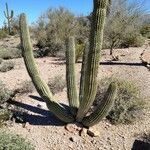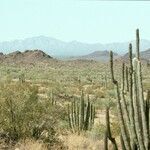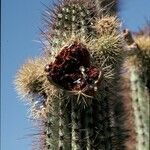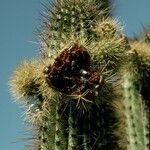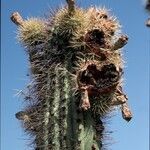Shrubs, branching basal, 3-6[-12+] m. Stems erect, at first yellow-green then green, lacking red pigmentation, glabrous and dull, forming patches of orange young bark on aged and undamaged segments; ribs [12-]15-19, somewhat tuberculate, interareolar transverse fold often present on young ribs, 9-12 mm to rib crest; cortex yellowish, mucilage sacs conspicuous in outer cortex only; pith lacking mucilage, 4-6 cm wide; areoles 1-1.6 cm apart along ribs, circular, 4-6 mm, hairs reddish brown. Spines 11-14(-19), thin, straight; radial spines 1-3.5 cm; central spines to 6 cm. Flowers nocturnal, mostly subterminal, funnelform, to 6-7.5(-9) × 6-7 cm; flower tubes about 4 cm; scales at base of tube red with green margins; tepals to 6.5 cm wide; outer tepals reddish with pink margins; inner tepals cream-white to light pink; filaments white to pink, 2-3 cm; ovary tuberculate with green, rhomboid tubercles and small red bracts at anthesis, areoles with tan hairs and sometimes short spines; styles white, 4 cm; nectar chamber 1-1.5 cm. Fruits red, 45-65 mm, fleshy, bearing deciduous spiny areoles; pulp sweet. Seeds 2 mm, glossy. 2n = 22.
More
A branched columnar cactus. It is greyish-green. The stems have red spines. The stems can be 2-3 m tall and 12 cm across. They form a cluster from the base. There are 12-17 prominent ribs. The spine spots are 1-2 cm apart. There are 7-9 spines which radiate out and are 1 cm long. And there are 1-3 central spines which are 2-5 cm long. The flowers are pink and 7 cm across. The fruit are edible. The fruit are 4 cm long. They lose their spines when ripe They are red outside and red or yellow inside
It is a subtropical plant. It needs bright sunlight. Mature plants can tolerate heavy frosts with only tip damage. Seedlings are damaged by frost. Plants need temperatures above 10°C to grow. It grows in arid and semiarid zones in the Sonoran Desert. It can grow in arid places. It suits hardiness zones 9-10.
More
Upland Sonoran desert scrub at elevations from 20-1,100 metres.
The fruit are eaten. They are also dried and stored and eaten as sweets. The pulp is boiled and used like jam. The seeds are parched and stored and used to make meal cakes. The seeds are dried and ground into a meal. The fruit are eaten fresh, skin and all. They are also dried or made into wines or syrups. The petals are also eaten.
